A few days ago we released the version 2.9.4 of App MD WiFi, introducing 2 specific new options for the virtual cycling training platforms like Zwift and more. Here are the details.
Relase 2.9.4 App MD WiFi | Delay setting for Optical Remote Control
The first introduction of the release 2.9.4 App MD WiFi is the delay setting for optical remote control (single or double button). This function allows you to set the time that elapses from the moment whend the button (optical remote control) is touched until the moment when the command is sent to JARVIS smart trainer. Previously, this time was equal to 2 seconds. Now it is possible to reduce this time with the chance of you getting a faster response.
Relase 2.9.4 App MD WiFi | Trim setting for Virtual Cycling Training Platforms
The second introduction of App MD WiFi Release 2.9.0 is the Trim setting for Virtual Cycling Training Platforms. It consists in the chance to adjust the resistance of magnetic brake when using the routes. Trim setting has effect EXCLUSIVELY when using the virtual cycling training platforms (like Zwift, Bkool, FulGaz, Rouvy AR and more) in the route mode.

A few weeks ago we introduced a small change within the MagneticDays AUTOTESTS. But first, let’s remind us all what AUTOTESTS are: autotests or self-tests are incremental test protocols available (free of charge) to all MD customers/users who own an account on our site. They are used to choose the best range of physiological parameters when it comes to writing a workout or riding a Self-Managed Workouts, or simply to know the fitness level after a period of inactivity.
Each MagneticDays AUTOTEST (seven in total) corresponds to an assumed threshold level (processed by an algorithm) and, for each one, both the warm-up and the start of the incremental test will change. What does the change consist of? Until recently, the athlete’s recovery was an active recovery, meaning that after reaching the maximum bearable wattage, the brake opened to give the possibility to recover by pedaling. From today, however, the recovery is passive (yellow area of the graph below), meaning that the athlete recovers “from a standstill” for the entire duration, which is decided by the MD Coach. We defined this as the recovery index, or the ability of the heart to reduce the heart rate at the end of an exercise. The speed with which the heart returns to a low frequency indicates the efficiency of the cardiovascular system. It is believed that the recovery index reflects the reactivation balance of the parasympathetic nervous system and the inhibition of the sympathetic nervous system[1].
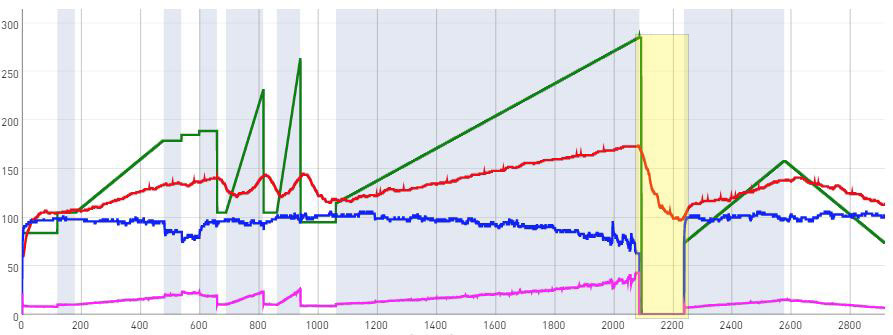
Cells need to rebuild ATP during recovery
It is necessary for cells to rebuild ATP (Adenosine triphosphate) after exertion, and this process takes place during recovery. In the first 10 seconds this is done by the anaerobic alactacid system (the re-synthesis of ATP by means of the creatine phosphate kinase enzyme). Subsequently – up to about 30 seconds – the anaerobic lactacid system is activated (splitting of glucose with production of ATP and lactic acid). From 30 seconds on, the aerobic system is more involved in the recovery.
The three recovery indexes (IDR), described in the report that the MagneticDays Coach sends to the athlete after each training block, indicate the efficiency of the energy systems at the end of a maximum effort, such as an incremental power test. In addition, they indicate the athlete’s resilience in the three areas as well as in general. This allows the MD Coach to calibrate each customized indoor training session, with the relative recoveries studied ad hoc.
The recovery indexes in the MagneticDays report
The recovery indexes highlighted in the MagneticDays report are:
- IRD AA: Anaerobic Alactic Recovery Index, or the ability to resynthesize ATP through the use of the enzyme creatine phosphate kinase (CPK);
- IDR AL: Anaerobic Lactacid Recovery Index, or the ability to resynthesize ATP through the use of anaerobic glycolysis;
- IDR AE: Aerobic Recovery Index, or the ability to resynthesize ATP through the use of the Krebs Cycle;
- IDR GENERAL: GENERAL Recovery Index, or the ability to resynthesize ATP through the use of all three systems.
How to read the recovery index
To read the recovery index, the following must be kept in mind: the number indicated in the report corresponds to the slope of the linear regression line intercepted through the points examined by the MD Coach. A low number corresponds to a poor recovery capacity, conversely, a high number means the athlete has a good recovery capacity. The numbers taken individually are not very useful. To understand whether the personalized indoor training has achieved its effects, it is necessary to compare them with the parameters of a subsequent incremental test. And this is one of the many advantages of the MagneticDays coaching service.
WE’RE BACK!
We’re back to work today after 2 months in smart working. During this time we did our best to make you feel less sad. We are full of enthusiasm and gratitude, in total compliance with the rules for the phase two of this coronavirus pandemic. The sun is shining in Val di Chiana and we wish you all the best. We are here. We have always been there. And we’ll be there every day.
MagneticDays continues to look to the future with hope, optimism and a great desire to start again, perfectly aware to be a resilient family-run business and innovative brand in the same time, constituted by a resistant group of people capable of coping with the unexpected with ingenuity and creativity.
Going fast uphill is one of the goals of many cycling, mountain bike and triathlon enthusiasts. The recent lockdown has presented many concerns to all athletes struggling to both keep fit and not lose all the hard work done until the end of February. In the run-up to phase 2, one of the most frequently asked question was: “Will I be able to go uphill as fast as before”?
My answer, short and reassuring, has always been: “Of course, actually, you will go faster”! “But how can I go fast uphill if I don’t pedal uphill”? More often than not was the reply! At this point, I want to share some principles of Physics by providing a detailed answer.
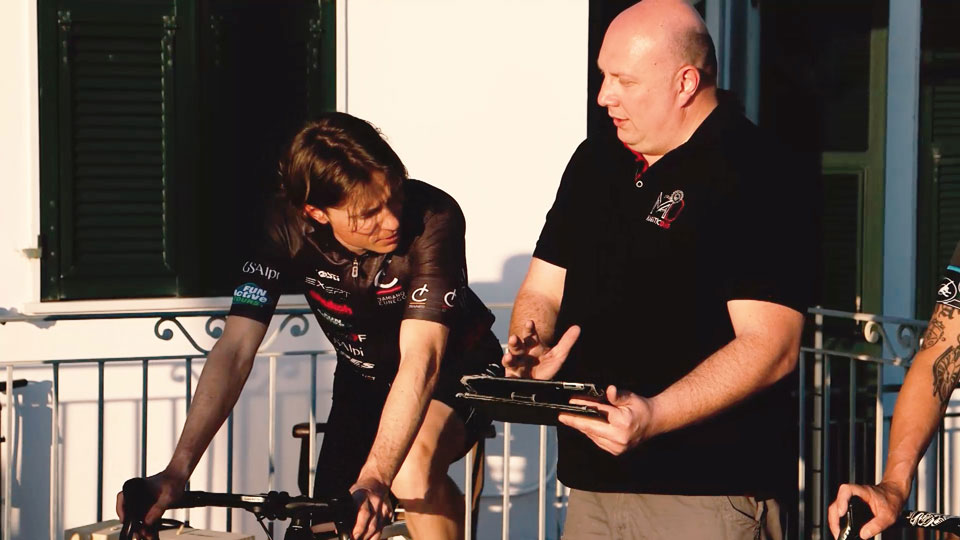
Let’s assume we have an athlete weighing 70 kg and a 7 kg bicycle with an additional 2.2 kg of weight between clothes and water bottles. Uphill, at a speed of 30 km/h, we estimate about 195 Watts. These Watts are used to overcome the resistances (front section, friction and slope being the main ones) and to maintain speed. At the same speed (30 km/h) – with a gradient of 1% – we must supply 261 Watts; at 2% 327 Watts, at 3% 293 Watts. If we want to keep the power constant of about 200 Watts, we must adjust the speed: with a gradient of 1% we will go 26 km/h, 2% 23 km/h, 3% 19.5 km/h. As we can see from these simple calculations, for the same wattage the speed must necessarily change. As previously stated, the three main factors that influence the forward movement are:
a) front section (also called drag), which increases proportionally to the speed;
b) force of gravity (which increases as the slope increases);
c) friction such as that generated by old bearings, deflated wheels or a dirty chain.
In the following table I summarized the numbers shown above with the addition of the gravity and drag factors.
| Slope
(%) |
Speed
(Km/h) |
Power
(Watt) |
Gravity
(% of the total) |
Drag
(% of the total) |
Other
(% of the total) |
| 0 % | 30 | 195 | 0 | 81 | 19 |
| 1 % | 26 | 191 | 30 | 54 | 16 |
| 2 % | 23 | 200 | 50 | 36 | 14 |
| 3 % | 19,5 | 194 | 65 | 23 | 12 |
As you can see, as the slope increases, the influence of gravity increases, while the drag decreases as speed decreases. The 3% gradient is an easily cycled climb for many cyclists. I used the weight of same person (plus gear) as an example, as we know the overall weight of the “cyclist-bicycle-clothes” system affects the weight/power ratio.
Now, going back to the initial question “how to go faster uphill”, there are many recommendations that can be found online, from technical tips to training with various repetitions. However, all these tips have one thing in common: to go fast uphill you need to increase your threshold power.
In normal conditions, in fact, we would do a long uphill at the intensity of the fondo medio, which we know is around 80% of our FTP. If we take our cyclist as an example, he should have a threshold of about 250 Watts. Using a bit of logical reasoning, if we increase the power of the anaerobic threshold by 5%, we go to 262 Watts, which is 210 Watts at 80%. In terms of speed, we are at 20.5 km/h at 3%, that is 1 kilometer per hour more compared to the previous condition. We have improved!
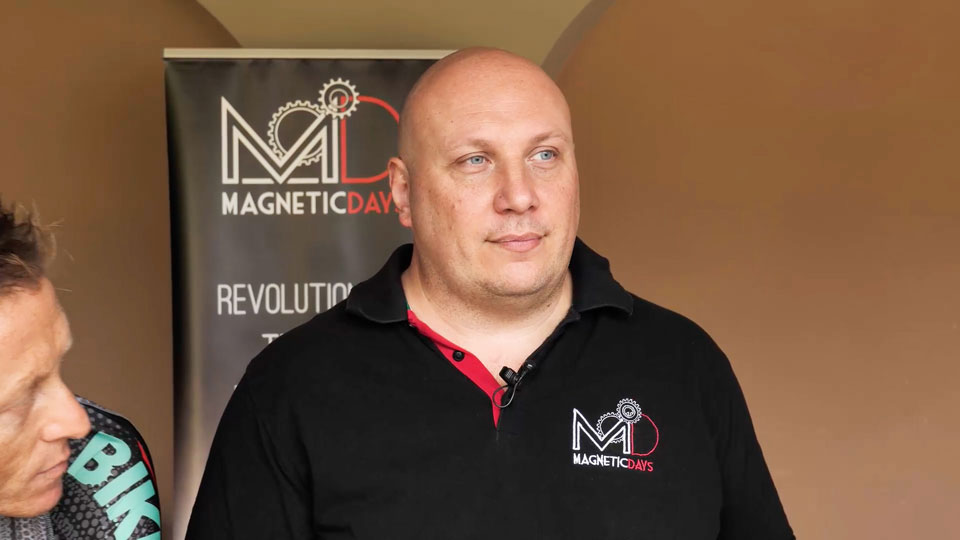
We always need to keep in mind that 200 Watts uphill or 200 Watts on a flat surface are the same. What changes is the speed. So, the opening question should be: “Does it make sense to train uphill to go fast uphill”? I suppose the answer is starting to be clear, but let’s make another consideration. When training with repetitions uphill, you can do shorter or longer repetitions. The intensity will decrease proportionally to the duration of the repetition. When you go below the threshold, the training stimulus is no longer aimed at increasing the threshold power but at being able to last longer. This is also a useful and necessary factor, but performing “al medio” will not reduce your climbing time at all.
To stimulate the body to increase the threshold it is necessary to provide stimuli around and beyond the threshold power, as we do for example at MagneticDays through the customized HTT training methodology expressed on JARVIS smart trainers. The question I ask you now – considering what has been said – is: “Is it therefore possible to go fast uphill with indoor training”? In indoor training we have 8+1 advantages that help us work on improving FTP. Let’s see them in detail:
- We exclude the limiting factors of performance (force of gravity, drag and various frictions);
- We have an optimal biomechanical efficiency;
- We exclude stopwatches, tables to follow and ideal routes to look for;
- We calibrate the intensities according to our abilities;
- We avoid U-turns in curves and crazy descents to get back into recovery time;
- We have the constant supply of working power and the consequent optimization of the cadence;
- We have the optimization of training times;
- We challenge our teammates on Sunday instead of thinking about repetitions;
- HTT protocols are personalized workouts aimed at improving performance and well-being.
In conclusion, I ask you: “Do you have to go uphill to go uphill”? Personally I am convinced that we must work on improving the individual performance, using an ideal training method and having patience and confidence for at least three weeks, which is the minimum time to appreciate the results. Then, if you want, nothing (but further lockdowns!) prevents you from getting on your bike and going to train uphill.
PS: The calculation of the weight / power ratio (the famous Watt/Kg of body weight), are included in the category “force of gravity”. When you are outdoors, it is MANDATORY to calculate the body weight of your clothes before going out and add it to the weight of the bicycle with full bottles. That is, in fact, the overall weight when riding outdoors. In indoor training, the force of gravity is zero, so you just need to do the division using your won weight, and nothing more.
In this historic moment, with the world pandemic and all the associated limitations, many people are dedicating more time to indoor cycling. Sports help you fill your days, strengthen your body and your mind, optimize your time and keep yourself in good health. However, some people are beginning to show signs of impatience with the restrictions, and this impatience also turns into a hyperkinesia (an increase in muscular activity that can result in excessive normal or abnormal movements) in terms of training. It is known that sport is addictive and doing without it for a long period of time causes side effects comparable to the ones due to abstinence from substances such as tobacco. The healthy remedy, therefore, is to continue to practice sports, without “overreaching”. Overreaching is what scientists define as an “accumulation of stimuli, whether from training or not, which results in a short-term decrease in performance, with or without signs or related symptoms (physiological or psychological) of a poor adaptation, and where the recovery of performance can take several days or weeks.”

MagneticDays Coach Luca Bianchini offers us an interesting food for thought: “If in a normal day physical activity covers a part of the time, in this particular period in history the percentage of that time increases. The risks produced by an increase in physical activity at home are sometimes unpleasant. The intensity of indoor cycling is certainly greater than the outdoor one and this implies longer recovery times. Excessive sweating leads to a state of chronic dehydration that must necessarily be compensated for. The return to homeostasis is sometimes longer than normal. The first discomforts that are being observed due to the increase in physical activity are latent – continues Coach Bianchini – but they do not go unnoticed to a careful eye. If we used to train 3 or 4 times a week, now we train 7 days a week. Our body is not used to keeping up this rhythm and responds with fatigue. The first organ to give us a signal of this state is the heart. Heart rate struggles to drop adequately during the recovery phase, and stays high even during rest. In maximal efforts, then, it struggles to reach the usual peaks. This is where the use of a valuable tool comes into play: a heart rate monitor. The more advanced ones also provide cardiac variability, data that allows you to evaluate actual recovery. If paying attention to these tools is sometimes underestimated, the lack of serotonin can be stronger stimulant than common sense. If proper attention is not provided to recovery, many people will suffer from chronic overexertion at the end of this period. And this state is the prelude to overtraining, which is a real pathology.“
How to avoid overreaching
Expanding on what Coach Luca Bianchini just talked about, how can you avoid overreaching? And what are the recommended practices? “First of all – continues Coach Bianchini – the variety of training loads: at each high-intensity workout it is necessary to alternate two recovery workouts, in which the heart rate or the reference watts remain under the indications of zone 2 or below 70% of the heart rate threshold. Furthermore, drinking more water than usual, not all at once, but increasing the consumption by at least half a liter (even a liter) throughout the day, is recommended. The body needs water, not only during the indoor cycling session, but also immediately after, and it is even better to add a soluble preparation of salts (magnesium and potassium) and essential amino acids. It is also advisable to take the same supplements right before bedtime, to prevent the onset of nocturnal cramps. It might seem obvious and outdated, but I feel the need to reiterate a concept that I really care about: it is precisely during rest that improvements occur, not during training. Recovery is just as important as training, if not more. Following the instructions of a coach is essential to ensure the correct management of training during the week. If we want to reach the competitive season in the best shape possible, we need to use our head, not only our legs.”
From October 2019, we have uploaded 7 MagneticDays AUTOTESTS (incremental exercise test made without the supervision of a Coach) in each personal account of all MD users/clients on our website. But, what are the MagneticDays AUTOTESTS?
MagneticDays AUTOTESTS represent one of the most recent introduction in the smart training field by MagneticDays, totally free of charge and at the disposal of all MD users/clients in order to give them the opportunity to choose the best range of physiological parameters at threshold (Watt, Newton, Cadence and Hear Rate) in case of: 1) autowriting workout; 2) use of MagneticDays Self Managed Workouts; 3) know your physical conditions at a specific time.
Each MagneticDays AUTOTESTS corresponds to a theoretical threshold value (elaborated on an algorithmic basis) and, in each one, changes both the warm up and start of the incremental exercise test. The threshold values of the MagneticDays AUTOTESTS are obtained through an algorithm of our software, therefore it are to be considered a good starting point when you don’t have the support of a Coach, although these data can’t be replaced with those obtained by the analysis of a Coach.
“The MagneticDays AUTOTESTS – CEO MD Marco Sbragi says – are a part of our course of research and development that we are following to continuosly improve the level of custom-built training. The only difference with our incremental exercise tests is that the user/athlete carries out the workout in complete autonomy without the supervision of a Coach, obtaining an accurate valuation of the physical condition anyway.”

In the first part of this article we saw how indoor triathlon training with MagneticDays can be successfully used in planning the first three months of training for a Ironman athlete. In this second part we involved MD Coach Luca Bianchini to understand and analyze how to optimize the performance of an Ironman distance triathlon.
Organize your time to optimize performance
Time is one of the deciding factors in optimizing triathlon performance, particularly when dealing with an Ironman distance. And if this is true for professional athletes, it is even more true for amateurs, people who play sports for passion trying to carve out a few hours from a day full of personal, family and work commitments. Here are some factors to consider:
- Number of days to the target race | Let’s assume the race is at the end of June, you will have about 12 weeks of training (90 days). This hypothesis is valid for any race you want to play, not necessarily at the end of June. If the race is in October, just move the month of March to that of July. Joe Friel writes in his books that the three months before a goal race are the most important to have an optimal performance. We are only focusing here on the cycling part and on the personalized indoor training with MagneticDays and based on the type of race chosen, we will focus on consolidating the performance;
- Time available for training | The life of a professional athlete is all about training. The life of an amateur athlete also includes work, family and all other aspects of a typical day. The cycling segment is definitely the part that takes the longest to train, but sometimes you don’t have that time. This is why a training strategy with MagneticDays makes the most of the time available. An hour (or a little more) dedicated completely to improving performance without being bothered by traffic lights, holes, wind against or other cyclists. An hour without distractions and completely focused on the goal.
A good physical structure combined with proper planning allows the athlete to better manage workloads
In order to optimize performance in a triathlon race, it is necessary that the athlete is able to manage the daily workloads well, to train to the best of his/her ability but avoiding the risk of injuries. The factors to consider in this case are:
- Load capacity of the athlete | Each athlete, based on his/her history, can sustain different workloads. If you overdo these loads, you will soon find yourself tired. Through the athlete’s feedback the coach is able understand what the load capacity is. The training analysis, performed by the coach, makes it possible to understand if the athlete still has the ability to maintain the loads or if it is necessary to reduce them. This point is closely related to the following;
- Alternation between high-intensity and low-intensity training days | In a well-done training program it is also necessary to include periods of rest. Intrestingly enough, performance is not improved during the training, but druing the recovery period (that is, when the repair processes, stimulated by training take place). By not respecting this simple principle, you will risk chronic fatigue (initially) until you get to a real overtraining (if you persist). Even though low intensity workouts are often percieved as usless in terms of improving the performance, in reality, in sports such as triathlon, these low intensity workouts are necessary to develop the endurance necessary for the duration of the race. No matter if we are talking about the time of a sprint race or the over 9 hours of an Ironman, medium-low intensity workouts are as important as high-intensity ones.

Optimize training and triathlon performance with MagneticDays while having fun
Knowing how to optimize your training also includes the ability to have fun while doing it. Imagine what it might be like to train for an Ironman distance triathlon and do it reluctantly. It would be just a waste of time, also considering the level of physical and mental commitment that must be devoted to it every day. For this reason it is important that the coach and the athlete work together harmoniously, and that the following conditions are respected:
- Planning combined workouts (generally cycling-running) | These workouts are often underestimated because they take time and coordination. Generally, combined cycling-running training is planned because, once the cycling part is over, switching to the running phase seems as easy as putting on a pair of running shoes. But the transition from cycling to running is the most demanding in terms of muscles. Getting off the bike after 40 minutes, or 6 hours for that matter, and then running is an effort that must necessarily be trained. But even going from lying down (swimming) to standing (running to get to the transition area) is something that needs to be trained. Taking your MagneticDays JARVIS smart trainer with you by the pool (if you have the pool’s authorization in advance, that is), not only transforms indoor training into an outdoor one, but also represents an optimal solution for performing combined swimming-cycling. The Jarvis battery guarantees safety on the poolside. And you will be using your own bike, allowing you to have the biomechanical adaptations needed. Also adding the part where you remove your wetsuit and change, allows you to actually train all aspects of the race, and specify even more the T1. Furthermore, using the MD WiFi App on your phone or tablet allows you to perform a specific workout based on the performance model of the target race. Simulating T2 allows you to make training even more stimulating;
- Interpretation of the race performance model | The swimming and running fractions in the various triathlons have few variables, depending on the course. The cycling fraction has many more variables. From the sprint to the Ironman, from a road race to an off-road, the variables are many. Analyzing the performance model allows you to optimize specific workouts. The potential for compiling workouts based on the performance model makes training more and more specific. Many athletes upload the elevation profile of the segments or the entire cycling portion of their races on the web. Taking advantage of this, training on the Jarvis smart trainer becomes much more than a simulation, experiencing the same sensations that will be experienced in the race;
- Optimize the deficient discipline | Those who approach triathlon normally come from one of the three disciplines. For one reason or another, it often happens that one or two of the three disciplines are more deficient than the others. For those coming from swimming, running could be an obstacle. For a runner, swimming is usually the impediment. On the other hand, cycling is the discipline that can most easily be trained (from a metabolic point of view). The technical aspect of the bike is guaranteed by the biomechanical; the driving technique can be learned. The metabolic part can be trained easily. The certainty of being able to perform a personalized workout with MagneticDays, comfortably at home, allows you to improve performance without the dangers of the road.
In the third and last article dedicated to triathlon, we will find out how to optimize the performance in Ironman distance triathlon training. If you missed the first part, don’t worry! Here’s how MD technology can be used successfully in planning an Ironman athlete’s first three months of the season.
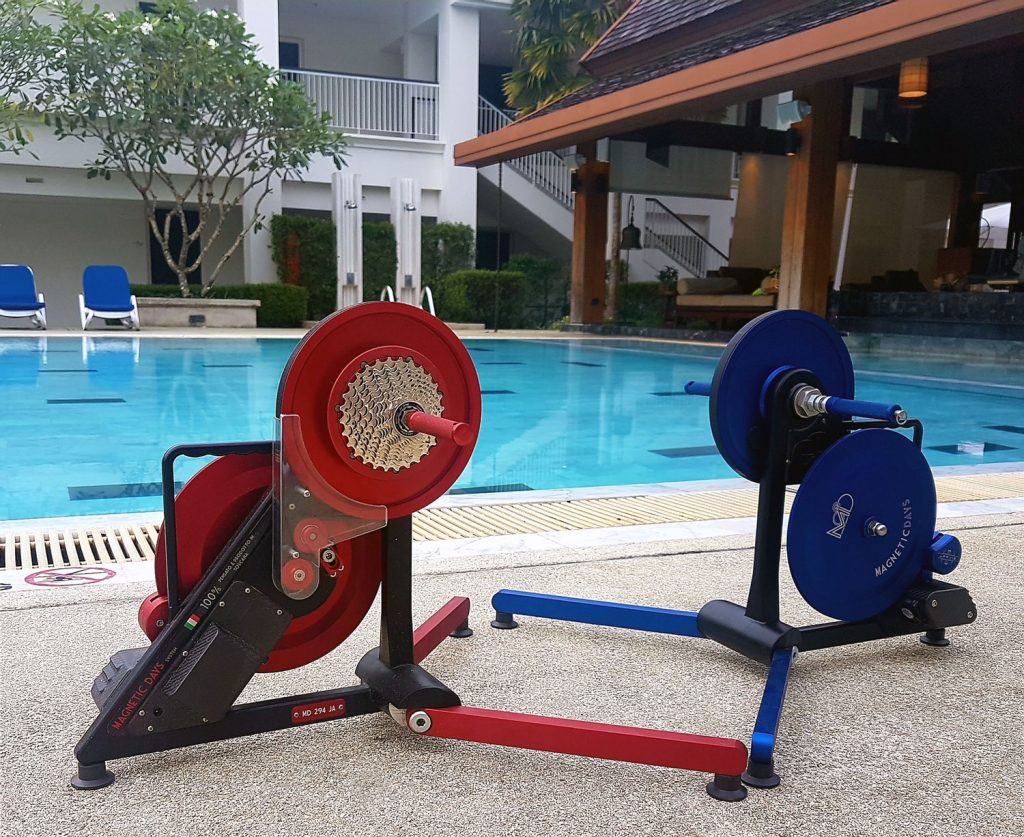 b
b
Indoor triathlon training, especially Ironman distance training, is increasingly present in the life of athletes, amateurs and professionals. If before “smart training” was considered an option for a few, today it is becoming an integral part of a training strategy aimed at optimizing the performance for many. A multipurpose tool like MagneticDays JARVIS smart trainer allows the coach (and the athlete) to introduce specific quality indoor cycling sessions within a weekly schedule.
The use of MD JARVIS smart trainer in weekly indoor training: when and why.
For an athlete, the first three months of each new triathlon season are the most important ones because they test the results of all the hard work carried out during the off season. Once you get to the race, finding the right rhythm, the right pace is key. To do this you need to build endurance, which is gradually developed during each training session. In any triathlon race, especially on Ironman distance, the cycling segment represents a crucial part, certainly the longest portion, and this is why it is fundamental to train it at best without loading the body with exhausting workouts that, in the long run, can only worsen the performance.
“The functional evaluation test with JARVIS – says MD Coach Luca Bianchini – has a dual purpose. It serves both as a verification of the work done during winter and as a starting point for preparing a set of workouts aimed at optimizing the physical condition in progress, and therefore, performance. At first, the new threshold and the respective training zones are identified, both in terms of Watt and heart rate. Then, we analyze the characteristics of the cadence and the over-the-threshold capacity to understand how you can intervene to improve performance. All this keeping in mind that during the first three months of the season the athlete, and his/her body, needs to get used to a more constant pace of physical and mental effort.”
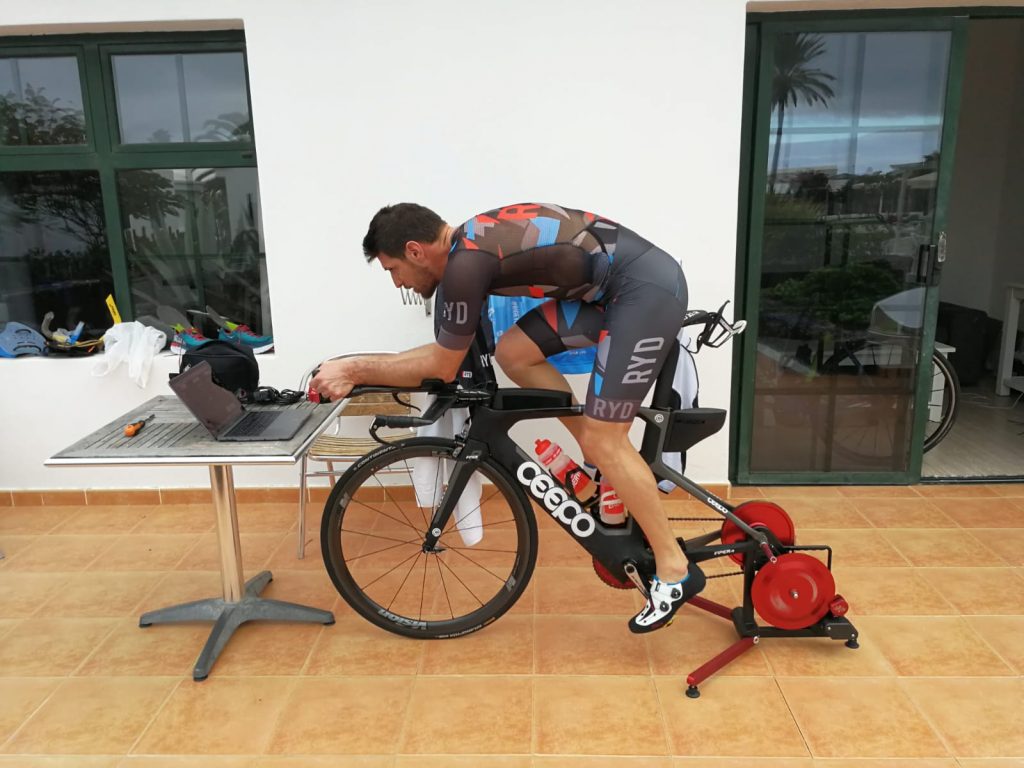
The advantages of a MagneticDays personalized training program
A personalized training program must necessarily start from good planning. The underlying concept of the HTT methodology is to follow the polarized method. This training method consists in investing about 75-80% of the training volume in the aerobic zone, while the remaining is at high intensity. Considering that an amateur athlete spends approximately 10 hours of training for the cycling part (cycling and triathlon), about 7-8 are typically performed on the weekend with long rides. The remaining 2 hours of training should be done at high intensity. These two hours of high intensity training can be carried on MagneticDays JARVIS smart trainer to perform HTT workouts and thus optimize the indoor training program.
“The concept behind every workout – continues Coach MD Luca Bianchini – is to increase and improve performance which, in the case of cycling, translates into the supply of more watt at the same heart rate. Using the heart rate (internal load) as an absolute reference can sometimes be misleading. In case of fatigue, the heart struggles to rise and to modulate based on the watt delivered, while the watt (external load) are always the same and do not take into account the physical state of the athlete. With MD JARVIS smart trainer, the heart can be seen as an internal state control system which follows an external load that the coach is able to verify together with the athlete’s feedback. Increasing the threshold watts is not enough for excellent performance. Theoretically the threshold is the power that we can maintain for about 60 minutes, but not everybody can do this, sometimes because those watts have not been consolidated.”
In this time of the year (from March to June), when the Ironman triathlon season has not yet started, we are in the optimal period to consolidate the performance improved during the winter. The first races will serve as a test to see if the programming has had its effects. Each athlete’s goals are different. There are those who want to compete a race for the pleasure of doing it, and those who want to achieve important goals (from the podium to the Italian sprint triathlon Championship to the final of the Ironman in Hawaii). What unites all these athletes and the variety of their goals is to perform at their top during the competition. The best training for a race is the race itself, but you obviously cannot compete every week and expect a perfect performance every competition. Furthermore, to train for triathlon, where the effort is 100%, you need to follow an even more focused program.
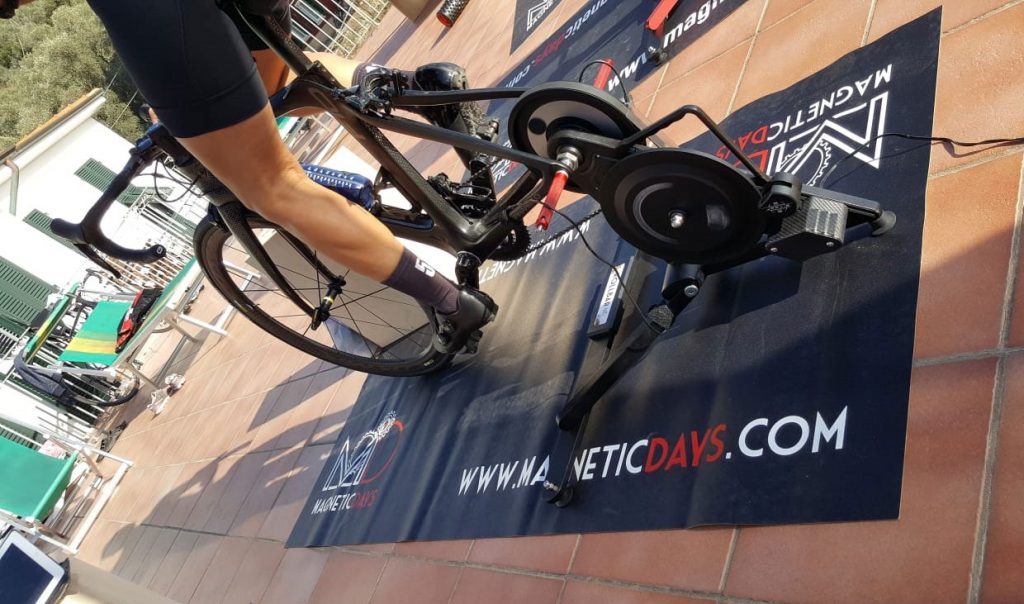
If we are only talking about one of the three disciplines in triathlon (cycling) programming is quite simple, but being able to perfectly modulate all three disciplines is complex. There are some factors that must be taken into account:
- number of days until the target race
- time available for training
- load capacity of the athlete
- alternation between days of high intensity and low intensity
- training insertion of combined workouts (generally cycling-running)
- interpretation of the performance model
- enhancement of the deficient discipline
These are just a few points a coach needs to keep in mind to optimize the annual schedule. In the second part of this article we will analyze how to optimize the performance in triathlon.
The Self-Calibrating Workout on JARVIS smart trainer is a type of workout studied by MagneticDays, in collaboration with the University of Verona, that can be used as a “guideline” in case you do not have the support of an MD Coach (different from the HTT – High Tech Training methodology), which, to date, represents the top possible scientific personalization of a training carried out on any type of smart trainers currently on the market, and with the supervision of a Coach. Specifically, Self-Calibrating Workout represents a series of protocols designed to allow the user/athlete to perform a good workout when the optimal conditions for doing so are lacking. Here’s what Simone Buracchi, head of the MD technical area, had to say.
Self-Calibrating MD Workout: why and when to use it
Self-Calibrating Workout is the most effective training that can be done – if done well – without the presence of a Coach. Normally, when performing an incremental test, the MD Coach observes the results and accurately identifies the frequency threshold values, with the aim of setting the first cycle of tailor-made workouts. On the other hand, with Self-Calibrating Workout, the Coach cannot personally verify what the user/athlete has done, and the protocol we studied in collaboration with the University of Verona comes into play. We evaluated the individual incremental tests by observing where the threshold was placed on average with respect to the last step performed according to the protocol used. In the case of the 1:6 protocol (1 watt every 6 seconds) the threshold fell on average around 82% – 80% of the last work step completed, while in the 1:3 protocol (1 watt every 3 seconds) the threshold fell on average around 76% – 74% of the last work step completed.
The only “scientific” aspect taken into consideration for the drafting of the self-calibrating protocol (i.e. the data as close as possible to reality), is to understand how much, at a statistical level, the threshold is set with respect to the type of protocol used, without having a Coach. This type of training, performed with this criterion and specific for the required methods, is used to evaluate the condition of the user/athlete at a precise moment. While our classic incremental test is performed after 25/30 minutes from having performed an adequate warm-up first and some exercises after, the self-calibrating workout is performed at the beginning of the training (protocol 1:3, 1 watt every 3 seconds) right after a short warm-up phase. Nonetheless, I’d like to remind everybody that behind the infinite possibilities offered by the JARVIS indoor training system there is always and in any case knowledge. This tool can do anything, and does everything the coach tells it to do. With this concept in mind, we structured the self-calibrating workout by telling the instrument, once the user/athlete finishes the test, to analyze the last work step completed by subtracting a previously estimated X value. Consequently the second part of the exercise is structured automatically on the basis of the values calculated at that precise moment. It goes without saying that, for greater accuracy, the support of an MD Coach is always recommended. However, we believe that this way we can provide accurate data with the aim of delivering a test that is appropriate at the precise moment in which it is used.
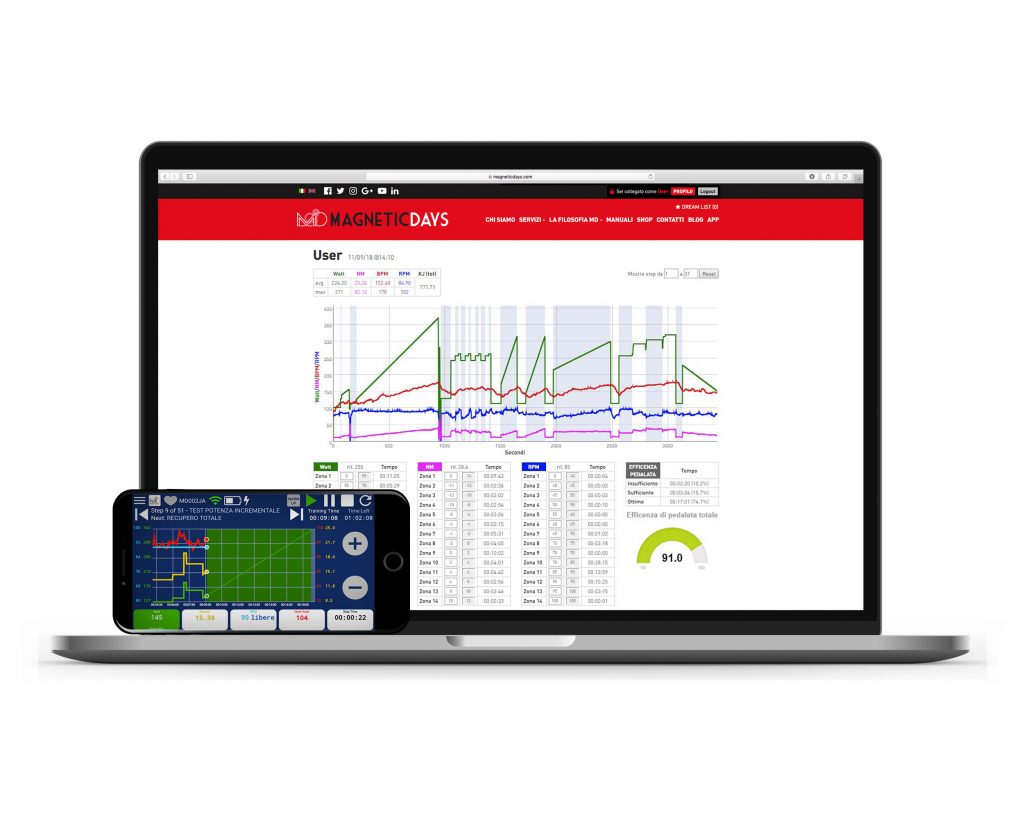
How is an MD Self-Calibrating Workout structured?
The first part of the self-calibrating workout consists of the incremental test (warm-up + 1:3 protocol). With this type of protocol (1 watt every 3 seconds), which lasts less than the classic 1:6, the user/athlete feels more fatigue but for a shorter time. The test is certainly shorter in terms of duration but with a wider gap regarding the rounding of the data. The second part, on the other hand, consists of the workout that the instrument processes with the values based on the incremental test just performed.
In which cases is Self-Calibrating Workout on MD smart trainers recommended?
We normally recommend it anytime you don’t feel 100% of your normal psychophysical condition. That is to say, if you feel intensely fatigued and a particular workout assigned by your MD Coach (who deems you in suitable conditions to carry it out) requires too big an effort, the self-calibrating workout option comes into play with the aim of providing an assessment of the user’s/athlete’s state of fitness at that moment. So feel free to do this workout whenever you feel that your condition is not at its best. This is an effective training, but keep in consideration that the actual calculation of the threshold value is always better than an estimated one.









